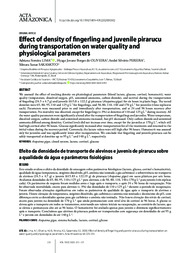Effect of density of fingerling and juvenile pirarucu during transportation on water quality and physiological parameters.
Effect of density of fingerling and juvenile pirarucu during transportation on water quality and physiological parameters.
Autoria: LIMA, A. F.; OLIVEIRA, H. J. B. de; PEREIRA, A. S.; SAKAMOTO, S. S.
Resumo: We assessed the effect of stocking density on physiological parameters (blood lactate, glucose, cortisol, hematocrit), water quality (temperature, dissolved oxygen, pH, unionized ammonia, carbon dioxide), and survival during the transportation of fingerling (24.5 ± 4.7 g) and juvenile (615.8 ± 122.2 g) pirarucu (Arapaima gigas) for six hours in plastic bags. The tested densities were 65, 80, 95, 110 and 125 g L-1 for fingerlings, and 50, 80, 110, 140 and 170 g L-1 for juveniles (three replicates each). Parameters were measured prior to and immediately after transportation, and at 24 and 96 hours recovery after transportation. No mortality was observed, except for fingerlings (< 3%) at densities of 110 and 125 g L-1 during recovery. All the water quality parameters were significantly altered after the transportation of fingerlings and juveniles. Water temperature, dissolved oxygen, carbon dioxide and unionized ammonia increased, but pH decreased. Only carbon dioxide and unionized ammonia differed among densities. Cortisol levels did not increase over time, except for the juveniles at 170 g L-1, which still had high cortisol after 96 hours. Glucose significantly increased after transportation for all the treatments and returned to the initial values during the recovery period. Conversely, the lactate values were still high after 96 hours. Hematocrit was assessed only for juveniles and was significantly lower after transportation. We conclude that fingerling and juvenile pirarucu can be safely transported at densities up to 95 g L-1 and 140 g L-1, respectively.
Ano de publicação: 2020
Tipo de publicação: Artigo de periódico
Unidade: Embrapa Pesca e Aquicultura
Palavras-chave: Alevino, Arapaima gigas, Cortisol, Fingerlings, Fish, Glicose, Glucose, Lactates, Peixe, Pirarucu, Qualidade da Água, Water quality
Observações
1 - Por padrão são exibidas publicações dos últimos 20 anos. Para encontrar publicações mais antigas, configure o filtro ano de publicação, colocando o ano a partir do qual você deseja encontrar publicações. O filtro está na coluna da esquerda na busca acima.
2 - Para ler algumas publicações da Embrapa (apenas as que estão em formato ePub), é necessário ter, no celular ou computador, um desses softwares gratuitos. Sistemas Android: Google Play Livros; IOS: iBooks; Windows e Linux: software Calibre.
Acesse outras publicações
Acesse a Base de Dados da Pesquisa Agropecuária (BDPA) para consultar o acervo completo das bibliotecas da Embrapa.

